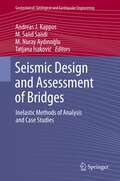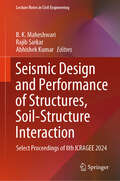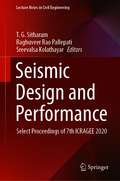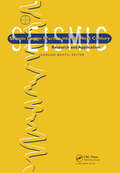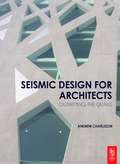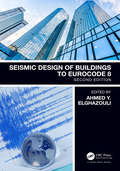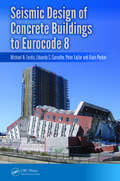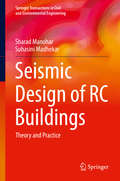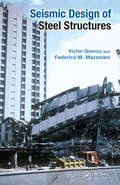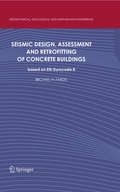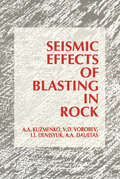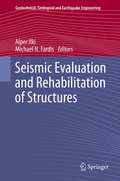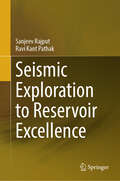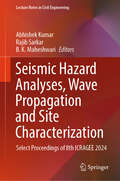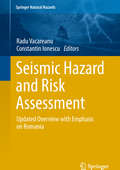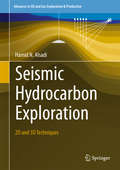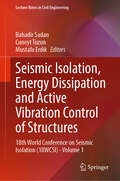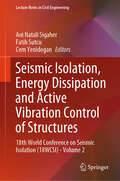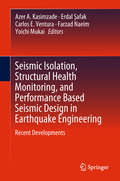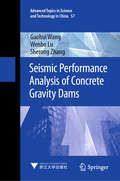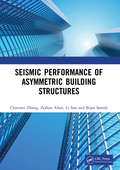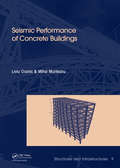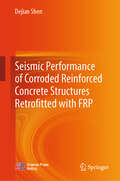- Table View
- List View
Seismic Design and Assessment of Bridges
by M. Nuray Aydınoğlu M. Saiid Saiidi Tatjana Isaković Andreas J KapposThe book focuses on the use of inelastic analysis methods for the seismic assessment and design of bridges, for which the work carried out so far, albeit interesting and useful, is nevertheless clearly less than that for buildings. Although some valuable literature on the subject is currently available, the most advanced inelastic analysis methods that emerged during the last decade are currently found only in the specialised research-oriented literature, such as technical journals and conference proceedings. Hence the key objective of this book is two-fold, first to present all important methods belonging to the aforementioned category in a uniform and sufficient for their understanding and implementation length, and to provide also a critical perspective on them by including selected case-studies wherein more than one methods are applied to a specific bridge and by offering some critical comments on the limitations of the individual methods and on their relative efficiency. The book should be a valuable tool for both researchers and practicing engineers dealing with seismic design and assessment of bridges, by both making the methods and the analytical tools available for their implementation, and by assisting them to select the method that best suits the individual bridge projects that each engineer and/or researcher faces.
Seismic Design and Performance of Structures, Soil-Structure Interaction: Select Proceedings of 8th ICRAGEE 2024 (Lecture Notes in Civil Engineering #567)
by Abhishek Kumar Rajib Sarkar B. K. MaheshwariThis book will present the select proceedings of the 8th International Conference on Recent Advances in Geotechnical Earthquake Engineering and Soil Dynamics (8ICRAGEE) held at the Indian Institute of Technology (IIT), Guwahati between December 11 and 14, 2024. It contains the latest research papers covering the contributions and accomplishments in geotechnical earthquake engineering and soil dynamics in the last four years. The five volumes of the book cover a wide range of topics, including but not limited to seismic hazard analysis, wave propagation and site characterization, dynamic properties and liquefaction of soils, pile foundations, offshore foundations, seismic design of retaining structures and dams, seismic slope stability and landslides, dynamic soil-structure interaction, seismic design of structures. Further, recent developments on these topics are covered in different chapters. This book will be valuable not only for researchers and professionals but also for drawing an agenda for future courses of action from the perspective of geotechnical earthquake engineering, keeping the national need at the forefront.
Seismic Design and Performance: Select Proceedings of 7th ICRAGEE 2020 (Lecture Notes in Civil Engineering #120)
by T. G. Sitharam Sreevalsa Kolathayar Raghuveer Rao PallepatiThis volume presents select papers presented at the 7th International Conference on Recent Advances in Geotechnical Earthquake Engineering and Soil Dynamics. The papers discuss advances in the fields of soil dynamics and geotechnical earthquake engineering. Some of the themes include seismic design of deep & shallow foundations, soil structure interaction under dynamic loading, marine structures, etc. A strong emphasis is placed on connecting academic research and field practice, with many examples, case studies, best practices, and discussions on performance based design. This volume will be of interest to researchers and practicing engineers alike.
Seismic Design and Practice into the Next Century: Proceedings of the 6th SECED conference, Oxford, 26-27 March 1998
by Edmund BoothThe papers, from 18 countries in Europe and elsewhere, contain discussions of quite radical innovations in material technology, design philosophy, experimental techniques and analytical approaches that will affect seismic design practice into the next century. Papers are organised into 9 sections: Ground motion and seismic hazard studies; Seismic design of foundations; Seismic design of steel, concrete and masonry buildings; Seismic design of offshore, nuclear and petrochemical installations; Seismic design of bridges, dock and power station structures; Repair and strengthening of bridges and buildings; Active and passive methods of seismic control; Dynamic testing methods; Seismic codes of practice. The proceedings will provide essential material for all those from both industrial and research organisations needing to keep in touch with the state-of-the-art in earthquake engineering and related earch sciences.
Seismic Design for Architects
by Andrew CharlesonSeismic Design for Architects shows how structural requirements for seismic resistance can become an integral part of the design process. Structural integrity does not have to be at the expense of innovative, high standard design in seismically active zones.* By emphasizing design and discussing key concepts with accompanying visual material, architects are given the background knowledge and practical tools needed to deal with aspects of seismic design at all stages of the design process * Seismic codes from several continents are drawn upon to give a global context of seismic design * Extensively illustrated with diagrams and photographs* A non-mathematical approach focuses upon the principles and practice of seismic resistant design to enable readers to grasp the concepts and then readily apply them to their building designsSeismic Design for Architects is a comprehensive, practical reference work and text book for students of architecture, building science, architectural and civil engineering, and professional architects and structural engineers.
Seismic Design of Buildings to Eurocode 8
by Ahmed Y. ElghazouliThis book focuses on the seismic design of building structures and their foundations to Eurocode 8. It covers the principles of seismic design in a clear but brief manner and then links these concepts to the provisions of Eurocode 8. It addresses the fundamental concepts related to seismic hazard, ground motion models, basic dynamics, seismic analysis, siting considerations, structural layout, and design philosophies, then leads to the specifics of Eurocode 8. Code procedures are applied with the aid of walk-through design examples which, where possible, deal with a common case study in most chapters. As well as an update throughout, this second edition incorporates three new and topical chapters dedicated to specific seismic design aspects of timber buildings and masonry structures, as well as base-isolation and supplemental damping. There is renewed interest in the use of sustainable timber buildings, and masonry structures still represent a popular choice in many areas. Moreover, seismic isolation and supplemental damping can offer low-damage solutions which are being increasingly considered in practice. The book stems primarily from practical short courses on seismic design which have been run over a number of years and through the development Eurocode 8. The contributors to this book are either specialist academics with significant consulting experience in seismic design, or leading practitioners who are actively engaged in large projects in seismic areas. This experience has provided significant insight into important areas in which guidance is required.
Seismic Design of Concrete Buildings to Eurocode 8
by Alain Pecker Michael Fardis Eduardo Carvalho Peter FajfarAn Original Source of Expressions and Tools for the Design of Concrete Elements with EurocodeSeismic design of concrete buildings needs to be performed to a strong and recognized standard. Eurocode 8 was introduced recently in the 30 countries belonging to CEN, as part of the suite of Structural Eurocodes, and it represents the first European Stand
Seismic Design of RC Buildings
by Sharad Manohar Suhasini MadhekarThis book is intended to serve as a textbook for engineering courses on earthquake resistant design. The book covers important attributes for seismic design such as material properties, damping, ductility, stiffness and strength. The subject coverage commences with simple concepts and proceeds right up to nonlinear analysis and push-over method for checking building adequacy. The book also provides an insight into the design of base isolators highlighting their merits and demerits. Apart from the theoretical approach to design of multi-storey buildings, the book highlights the care required in practical design and construction of various building components. It covers modal analysis in depth including the important missing mass method of analysis and tension shift in shear walls and beams. These have important bearing on reinforcement detailing. Detailed design and construction features are covered for earthquake resistant design of reinforced concrete as well as confined and reinforced masonry structures. The book also provides the methodology for assessment of seismic forces on basement walls and pile foundations. It provides a practical approach to design and detailing of soft storeys, short columns, vulnerable staircases and many other components. The book bridges the gap between design and construction. Plenty of worked illustrative examples are provided to aid learning. This book will be of value to upper undergraduate and graduate students taking courses on seismic design of structures.
Seismic Design of Steel Structures
by Federico Mazzolani Victor GioncuProviding real world applications for different structural types and seismic characteristics, Seismic Design of Steel Structures combines knowledge of seismic behavior of steel structures with the principles of earthquake engineering. This book focuses on seismic design, and concentrates specifically on seismic-resistant steel structures. Drawing o
Seismic Design, Assessment and Retrofitting of Concrete Buildings
by Michael N. FardisReflecting the historic first European seismic code, this professional book focuses on seismic design, assessment and retrofitting of concrete buildings, with thorough reference to, and application of, EN-Eurocode 8. Following the publication of EN-Eurocode 8 in 2004-05, 30 countries are now introducing this European standard for seismic design, for application in parallel with existing national standards (till March 2010) and exclusively after that. Eurocode 8 is also expected to influence standards in countries outside Europe, or at the least, to be applied there for important facilities. Owing to the increasing awareness of the threat posed by existing buildings substandard and deficient buildings and the lack of national or international standards for assessment and retrofitting, its impact in that field is expected to be major. Written by the lead person in the development of the EN-Eurocode 8, the present handbook explains the principles and rationale of seismic design according to modern codes and provides thorough guidance for the conceptual seismic design of concrete buildings and their foundations. It examines the experimental behaviour of concrete members under cyclic loading and modelling for design and analysis purposes; it develops the essentials of linear or nonlinear seismic analysis for the purposes of design, assessment and retrofitting (especially using Eurocode 8); and gives detailed guidance for modelling concrete buildings at the member and at the system level. Moreover, readers gain access to overviews of provisions of Eurocode 8, plus an understanding for them on the basis of the simple models of the element behaviour presented in the book. Also examined are the modern trends in performance- and displacement-based seismic assessment of existing buildings, comparing the relevant provisions of Eurocode 8 with those of new US prestandards, and details of the most common and popular seismic retrofitting techniques for concrete buildings and guidance for retrofitting strategies at the system level. Comprehensive walk-through examples of detailed design elucidate the application of Eurocode 8 to common situations in practical design. Examples and case studies of seismic assessment and retrofitting of a few real buildings are also presented. From the reviews: "This is a massive book that has no equal in the published literature, as far as the reviewer knows. It is dense and comprehensive and leaves nothing to chance. It is certainly taxing on the reader and the potential user, but without it, use of Eurocode 8 will be that much more difficult. In short, this is a must-read book for researchers and practitioners in Europe, and of use to readers outside of Europe too. This book will remain an indispensable backup to Eurocode 8 and its existing Designers' Guide to EN 1998-1 and EN 1998-5 (published in 2005), for many years to come. Congratulations to the author for a very well planned scope and contents, and for a flawless execution of the plan". AMR S. ELNASHAI "The book is an impressive source of information to understand the response of reinforced concrete buildings under seismic loads with the ultimate goal of presenting and explaining the state of the art of seismic design. Underlying the contents of the book is the in-depth knowledge of the author in this field and in particular his extremely important contribution to the development of the European Design Standard EN 1998 - Eurocode 8: Design of structures for earthquake resistance. However, although Eurocode 8 is at the core of the book, many comparisons are made to other design practices, namely from the US and from Japan, thus enriching the contents and interest of the book". EDUARDO C. CARVALHO
Seismic Effects of Blasting in Rock
by A.A. DauetasThe results of theoretical and experimental investigations of seismic waves depending on natural and technological factors are discussed, with methods for engineering calculations of industrial blast parameters.
Seismic Evaluation and Rehabilitation of Structures
by Michael N. Fardis Alper IlkiIn the past, facilities considered to be at the end of their useful life were demolished and replaced with new ones that better met the functional requirements of modern society, including new safety standards. Humankind has recently recognised the threats to the environment and to our limited natural resources due to our relentless determination to destroy the old and build anew. With the awareness of these constraints and the emphasis on sustainability, in future the majority of old structures will be retrofitted to extend their service life as long as feasible. In keeping with this new approach, the EU's Construction Products Regulation 305/2011, which is the basis of the Eurocodes, included the sustainable use of resources as an "Essential Requirement" for construction. So, the forthcoming second generation of EN-Eurocodes will cover not only the design of new structures, but the rehabilitation of existing ones as well. Most of the existing building stock and civil infrastructures are seismically deficient. When the time comes for a decision to prolong their service life with the help of structural and architectural upgrading, seismic retrofitting may be needed. Further, it is often decided to enhance the earthquake resistance of facilities that still meet their functional requirements and fulfil their purpose, if they are not earthquake-safe. In order to decide how badly a structure needs seismic upgrading or to prioritise it in a population of structures, a seismic evaluation is needed, which also serves as a guide for the extent and type of strengthening. Seismic codes do not sufficiently cover the delicate phase of seismic evaluation nor the many potential technical options for seismic upgrading; therefore research is on-going and the state-of-the-art is constantly evolving. All the more so as seismic evaluation and rehabilitation demand considerable expertise, to make best use of the available safety margins in the existing structure, to adapt the engineering capabilities and techniques at hand to the particularities of a project, to minimise disruption of use, etc. Further, as old structures are very diverse in terms of their materials and layout, seismic retrofitting does not lend itself to straightforward codified procedures or cook-book approaches. As such, seismic evaluation and rehabilitation need the best that the current state-of-the-art can offer on all aspects of earthquake engineering. This volume serves this need, as it gathers the most recent research of top seismic experts from around the world on seismic evaluation, retrofitting and closely related subjects.
Seismic Exploration to Reservoir Excellence
by Sanjeev Rajput Ravi Kant PathakThis book unveils a comprehensive suite of seismic-to-reservoir excellence workflows meticulously designed to address the unique challenges posed by asset exploration, appraisal, and development. It offers a spectrum of solutions, from the simplest to the most intricate, tailored to accommodate varying volumes and quality of information. This includes the incorporation of decision-making using diverse data sources to make informed decisions while minimizing financial risk; offering strategies to mitigate risk and maximize ROI; and showcasing real-world success stories where these flexible workflows have been successfully applied. "Seismic Exploration to Reservoir Excellence" serves as a bridge between technical experts and professionals from various fields catering to students, researchers, industrial professionals, and global stakeholders who are interested in the vital energy security conversation of the 21st century- a conversation that aims to harmonize energy production with integrity environmental responsibility.
Seismic Hazard Analyses, Wave Propagation and Site Characterization: Select Proceedings of 8th ICRAGEE 2024 (Lecture Notes in Civil Engineering #571)
by Abhishek Kumar Rajib Sarkar B. K. MaheshwariThis book will present the select proceedings of the 8th International Conference on Recent Advances in Geotechnical Earthquake Engineering and Soil Dynamics (8ICRAGEE) held at the Indian Institute of Technology (IIT), Guwahati between December 11 and 14, 2024. It contains the latest research papers covering the contributions and accomplishments in geotechnical earthquake engineering and soil dynamics in the last four years. The five volumes of the book cover a wide range of topics, including but not limited to seismic hazard analysis, wave propagation and site characterization, dynamic properties and liquefaction of soils, pile foundations, offshore foundations, seismic design of retaining structures and dams, seismic slope stability and landslides, dynamic soil-structure interaction, seismic design of structures. Further, recent developments on these topics are covered in different chapters. This book will be valuable not only for researchers and professionals but also for drawing an agenda for future courses of action from the perspective of geotechnical earthquake engineering, keeping the national need at the forefront.
Seismic Hazard and Risk Analysis
by Peter Stafford Jack Baker Brendon BradleySeismic hazard and risk analyses underpin the loadings prescribed by engineering design codes, the decisions by asset owners to retrofit structures, the pricing of insurance policies, and many other activities. This is a comprehensive overview of the principles and procedures behind seismic hazard and risk analysis. It enables readers to understand best practises and future research directions. Early chapters cover the essential elements and concepts of seismic hazard and risk analysis, while later chapters shift focus to more advanced topics. Each chapter includes worked examples and problem sets for which full solutions are provided online. Appendices provide relevant background in probability and statistics. Computer codes are also available online to help replicate specific calculations and demonstrate the implementation of various methods. This is a valuable reference for upper level students and practitioners in civil engineering, and earth scientists interested in engineering seismology.
Seismic Hazard and Risk Assessment: Updated Overview With Emphasis On Romania (Springer Natural Hazards Ser.)
by Radu Vacareanu Constantin IonescuThis book contains the best contributions presented during the 6th National Conference on Earthquake Engineering and the 2nd National Conference on Earthquake Engineering and Seismology - 6CNIS & 2CNISS, that took place on June 14-17, 2017 in Bucharest - Romania, at the Romanian Academy and Technical University of Civil Engineering of Bucharest. The book offers an updated overview of seismic hazard and risk assessment activities, with an emphasis on recent developments in Romania, a very challenging case study because of its peculiar intermediate-depth seismicity and evolutive code-compliant building stock. Moreover, the book collects input of renowned scientists and professionals from Germany, Greece, Italy, Japan, Netherlands, Portugal, Romania, Spain, Turkey and United Kingdom.The content of the book focuses on seismicity of Romania, geotechnical earthquake engineering, structural analysis and seismic design regulations, innovative solutions for seismic protection of building structures, seismic risk evaluation, resilience-based assessment of structures and management of emergency situations. The sub-chapters consist of the best papers of 6CNIS & 2CNISS selected by the International Advisory and Scientific Committees. The book is targeted at researchers and experts in seismic hazard and risk, evaluation and rehabilitation of buildings and structures, insurers and re-insurers, and decision makers in the field of emergency situations and recovery activities.
Seismic Hydrocarbon Exploration
by Hamid N. AlsadiThis book presents the essential principles and applications of seismic oil-exploration techniques. It concisely covers all stages in exploration activities (data field acquisition, data processing and interpretation), supplementing the main text with a wealth of (>350) illustrations and figures. The book concentrates on the physics of the applied principles, avoiding intricate mathematical treatment and lengthy theoretical reasoning. A further prominent feature is the inclusion of a separate chapter on 3D surveying techniques and another, equally important chapter on seismic digital signals and the aliasing problem, which is presented in an accessible form. The book is designed to meet the needs of both the academic and industrial worlds. University students and employees of oil-exploration companies alike will find the book to be a valuable resource.
Seismic Isolation, Energy Dissipation and Active Vibration Control of Structures: 17th World Conference on Seismic Isolation (17WCSI) (Lecture Notes in Civil Engineering #309)
by Gian Paolo CimellaroThis volume gathers the proceedings of the 17th World Conference on Seismic Isolation (17WCSI), held in Turin, Italy on September 11-15, 2022. Endorsed by ASSISi Association (Anti-Seismic Systems International Society), the conference discussed state-of-the-art information as well as emerging concepts and innovative applications related to seismic isolation, energy dissipation and active vibration control of structures, resilience and sustainability. The volume covers highly diverse topics, including earthquake-resistant construction, protection from natural and man-made impacts, safety of structures, vulnerability, international standards on structures with seismic isolation, seismic isolation in existing structures and cultural heritage, seismic isolation in high rise buildings, seismic protection of non-structural elements, equipment and statues. The contributions, which are published after a rigorous international peer-review process, highlight numerous exciting ideas that will spur novel research directions and foster multidisciplinary collaboration among different specialists.
Seismic Isolation, Energy Dissipation and Active Vibration Control of Structures: 18th World Conference on Seismic Isolation (18WCSI) - Volume 1 (Lecture Notes in Civil Engineering #533)
by Mustafa Erdik Bahadir Sadan Cuneyt TuzunThis book gathers the proceedings of the 18th World Conference on Seismic Isolation (18WCSI), held in Antalya, Turkey, on November 6-10, 2023. Organized by Turkish Association for Seismic Isolation (TASI) and endorsed by Anti-Seismic Systems International Society (ASSISi Association), the conference discussed state-of-the-art information as well as emerging concepts and innovative applications related to seismic isolation, energy dissipation, and active vibration control of structures, resilience, and sustainability. The book covers highly diverse topics, including earthquake-resistant construction, protection from natural and man-made impacts, safety of structures, vulnerability, international standards on structures with seismic isolation, seismic isolation in existing structures and cultural heritage, seismic isolation in high-rise buildings, and seismic protection of non-structural elements, equipment, and statues.
Seismic Isolation, Energy Dissipation and Active Vibration Control of Structures: 18th World Conference on Seismic Isolation (18WCSI) - Volume 2 (Lecture Notes in Civil Engineering #412)
by Cem Yenidogan Ani Natali Sigaher Fatih SutcuThis book gathers proceedings of the 18th World Conference on Seismic Isolation (18WCSI), held in Antalya, Türkiye on November 6-10, 2023. Organized by the Turkish Association for Seismic Isolation (TASI) and endorsed by the Anti-Seismic Systems International Society (ASSISi), the conference discussed state-of-the-art information, as well as emerging concepts and innovative applications related to seismic isolation, energy dissipation, and active vibration control of structures, and resilience and sustainability. The volume covers highly diverse topics centered around energy dissipation devices. Chapters have been dedicated to the design and testing of energy dissipation devices, and the use of these devices in the design of structures, and retrofit of existing structures and cultural heritage. The contributions, which are published after a rigorous international peer-review process, highlight numerous exciting ideas that will spur novel research directions and foster multidisciplinary collaboration among different specialists.
Seismic Isolation, Structural Health Monitoring, and Performance Based Seismic Design in Earthquake Engineering: Recent Developments
by Carlos E. Ventura Farzad Naeim Azer A. Kasimzade Erdal Şafak Yoichi MukaiThis book features chapters based on selected presentations from the International Congress on Advanced Earthquake Resistance of Structures, AERS2016, held in Samsun, Turkey, from 24 to 28 October 2016.It covers the latest advances in three widely popular research areas in Earthquake Engineering: Performance-Based Seismic Design, Seismic Isolation Systems, and Structural Health Monitoring.The book shows the vulnerability of high-rise and seismically isolated buildings to long periods of strong ground motions, and proposes new passive and semi-active structural seismic isolation systems to protect against such effects. These systems are validated through real-time hybrid tests on shaking tables.Structural health monitoring systems provide rapid assessment of structural safety after an earthquake and allow preventive measures to be taken, such as shutting down the elevators and gas lines, before damage occurs. Using the vibration data from instrumented tall buildings, the book demonstrates that large, distant earthquakes and surface waves, which are not accounted for in most attenuation equations, can cause long-duration shaking and damage in tall buildings.The overview of the current performance-based design methodologies includes discussions on the design of tall buildings and the reasons common prescriptive code provisions are not sufficient to address the requirements of tall-building design. In addition, the book explains the modelling and acceptance criteria associated with various performance-based design guidelines, and discusses issues such as selection and scaling of ground motion records, soil-foundation-structure interaction, and seismic instrumentation and peer review needs. The book is of interest to a wide range of professionals in earthquake engineering, including designers, researchers, and graduate students.
Seismic Performance Analysis of Concrete Gravity Dams (Advanced Topics in Science and Technology in China #57)
by Gaohui Wang Wenbo Lu Sherong ZhangThis book evaluates the seismic performance of concrete gravity dams, considering the effects of strong motion duration, mainshock-aftershock seismic sequence, and near-fault ground motion. It employs both the extended finite element method (XFEM) and concrete damaged plasticity (CDP) models to characterize the mechanical behavior of concrete gravity dams under strong ground motions, including the dam-reservoir-foundation interaction. In addition, it discusses the effects of the initial crack, earthquake direction, and cross-stream seismic excitation on the nonlinear dynamic response to strong ground motions, and on the damage-cracking risk of concrete gravity dams.This book provides a theoretical basis for the seismic performance evaluation of high dams, and can also be used as a reference resource for researchers and graduate students engaged in the seismic design of high dams.
Seismic Performance of Asymmetric Building Structures
by Li Sun Chunwei Zhang Zeshan Alam Bijan SamaliSeismic Performance of Asymmetric Building Structures presents detailed investigations on the effective assessment of structural seismic response under excessive torsional vibrations, demonstrating behavioural aspects from local response perspective to global seismic demands. The work provides comprehensive analytical, computational, experimental investigations, and proposes improved design guidelines that structural engineers can utilize to enhance the seismic design of asymmetric building structures. Combining extensive experimental and numerical data stock for seismic performance assessment with a particular focus on asymmetric building structures, the book includes:• An overview of asymmetric building structures from seismic damage perspective• Local and global performance assessment of asymmetric structures under extreme seismic actions• Post-earthquake damage evaluation from varying frequency trends • Extended numerical applications for experimental response validations• Evaluation of critical regions of asymmetric structure with stress concentration• Statistical distribution of seismic response under varying design parameters• Design guidelines for asymmetric building structures This work's comprehensive evaluations are carried out with modern sensing techniques planned with meticulous attention to cover objectives with a particular focus on asymmetry in reinforced concrete and steel structures. It assesses various aspects of asymmetric building structures that are rarely dealt with in the current literature. It gathers fruitful information from various building design codes and explains their limitations in addressing damage-related challenges, which is not only useful for practicing engineers but also for academics. The book will be invaluable for experts, researchers, students and practitioners from relevant areas, as well as for emergency preparedness managers.
Seismic Performance of Concrete Buildings: Structures and Infrastructures Book Series, Vol. 9
by Liviu Crainic Mihai MunteanuThis book examines and presents essential aspects of the behavior, analysis, design and detailing of reinforced concrete buildings subjected to strong seismic activity. Seismic design is an extremely complex problem that has seen spectacular development in the last decades. The present volume tries to show how the principles and methods of earthqua
Seismic Performance of Corroded Reinforced Concrete Structures Retrofitted with FRP
by Dejian ShenThis monograph is written based on the author's research on seismic assessment and retrofitting of corrosion-damaged reinforced concrete structures during the recent two decades. It points out that reinforcement corrosion is one of the main reasons that contribute to the deterioration of the seismic performances and durability of reinforced concrete structures. It illustrates that the mechanism of reinforcement corrosion should be investigated to propose a method for evaluating the seismic performance of corroded components and structures. It calls for a comprehensive investigation on the bond performance between corroded reinforcing bars and concrete, as well as the degradation law of seismic performance of corroded beams, columns, beam column joints, and shear walls from the perspectives of materials, components, and structures. With the promotion and application of composite materials, fiber reinforced polymer (FRP) has been proposed as an ideal material for retrofitting reinforced concrete structures. By emphasizing the mechanism of reinforcement corrosion and the integrated evaluation of materials, components, and structures, this monograph offers an idea of using FRP to retrofit the seismic performance of corroded reinforced concrete structures. It is designed as a reference work for professionals or practitioners and a textbook for undergraduates or postgraduates. This book provides valuable knowledge and useful methods that can be considered in the field of seismic assessment and retrofitting of corrosion-damaged reinforced concrete structures with other FRPs.
